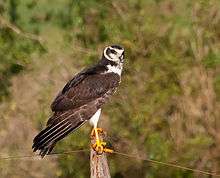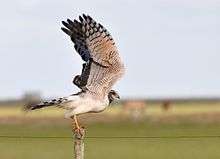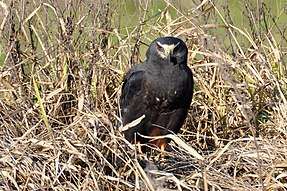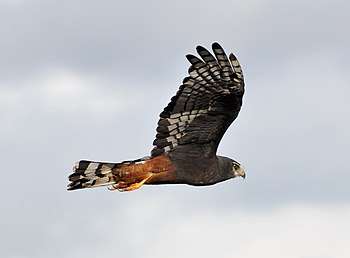Long-winged harrier
The long-winged harrier(Circus buffoni) is a common bird of prey species endemic to South America. They are members of the family Accipitridae, under the genus Circus which encompasses other harrier species. Its range encompasses most of South America, in grassland and wetland all across the continent.[2] The long-winged harrier is a carnivorous bird, and will feed on many different animals found in its habitat.[3]
| Long-winged harrier | |
|---|---|
 | |
| Scientific classification | |
| Kingdom: | Animalia |
| Phylum: | Chordata |
| Class: | Aves |
| Order: | Accipitriformes |
| Family: | Accipitridae |
| Genus: | Circus |
| Species: | C. buffoni |
| Binomial name | |
| Circus buffoni (Gmelin, 1788) | |
Like owls and other harrier species, the long-winged harrier has a distinctive facial disc, which is used to triangulate the bird's hearing while it is hunting.[4]
The long-winged harrier is classified as a species of least concern by the IUCN Red List, however their population has been observed to decline due to habitat degradation by human activity.
Description
The long-winged is mid-sized bird of prey, and like most birds of prey species, the females are larger than the males. Males will weigh from 390 g to 464 g (13.8 oz to 16.4 oz) and females will be slightly heavier, ranging from 400 g to 645 g (14.1 oz to 22.8 oz).[5] Their length can range between 46 cm and 60 cm (18.1 in to 23.6 in) and their wingspan ranges between 120 cm and 155 cm (47.2 in to 61.0 in).[5] As other harrier species, the lon-winged harrier can be identified by its long and narrow tail and its especially long wings.[6] Their wings and their back are mostly grey, with the primary feathers on the wings being much darker than the rest of the wing feathers, which are streaked with variants of white, grey and brown.[7]

The long-winged harrier can arbor 2 different morphs, a dark morph and a light morph. In dark morph individuals, the belly is all black with females having more of a brown undertone.[8] The light morph individuals can be identified by their white underparts, which contrasts heavily with their dark morph counterpart.[8] Juvenile long-winged harriers usually have the same colour patterns as females, but they have a more speckled chest.[9] The long-winged harrier morphologically resembles its close relative, the cinereous harrier (Circus cinereus), which can also be found in South America, but their range rarely overlaps.
As all other birds of prey species, the long-winged harrier possesses sharp talons used to catch their prey on the ground or in the air, and their legs are bright orange. The species also shares the large hooked beak of other birds of prey, which it uses to tear apart meat once it catches its prey.
The long-winged harrier is part of the only diurnal bird of prey group to possess a facial disc. The facial disc is formed by a group of easily recognizable group of feathers that form a disc shape around the bird's face.[4] These feathers can be raised in response to sounds and can improve the bird's hearing when it is hunting by triangulating sounds in its ear holes.[4]
Taxonomy
The long-winged harrier is classified in the genus Circus alongside 15 other harrier species, and it is most closely related to the cinereous harrier, which is the only other harrier species native to South America.[10] The genus name, penned by French naturalist Bernard Germain de Lacépède, can be translated from the Ancient Greek work kirkos meaning circle. This refers to the harrier's hunting strategy of flying in large circles in order to localize their prey.
The species name buffoni, referring to French naturalist and director of the Jardin du Roi George-Louis Leclerc Comte de Buffon, was first coined by German naturalist J.F. Gmelin in 1788, when the species was mistakenly classified under the genus Falco.[11][9][12]

Habitat and Distribution
The long-winged harrier's year-round range encompasses most of eastern South America, including eastern Argentina, Uruguay, Brazil and Paraguay, and extends up to Colombia, Venezuela, and the northern tips of Guyana, Suriname and French Guyana.[8][13] The species has also been observed occasionally in extant areas such as Bolivia, Peru, Chile, Trinidad and Tobago, and all the way down to Tierra del Fuego in southern Argentina.[8][13][9] It is vagrant to Panama and the Falkland Islands.[2]
This species occupies large grasslands and agricultural fields, where their wide-range active hunting technique is very effective. Their habitat also includes savanna, marshes and wetlands of South America.
Behavior
Vocalization
Little is known of the long-winged harrier's vocalization, as is not a very vocal bird. It will call mostly when in flight and some variation of the bird's call include a fast succession of "klee-klee-klee", and a more quiet "thrill" with a quickly descending pitch.

Diet
As all of the extended members of the family Accipitridae, the long-winged harrier is carnivorous, feeding on a large variety of animals due to its widespread distribution. Their diet includes small mammals, amphibians, reptiles and birds, with birds consisting the majority of their food intake.[3] Its hunting strategy differs vastly from other hawks sharing the same habitat such as the Roadside Hawk (Rupornis magnirostris).[14] Instead of opting for a passive hunting strategy consisting of the use of high perches to locate their prey, the long-winged harrier will fly slowly in large circles above its range in order to find its prey, using its keen vision and hearing.[14]
Reproduction
The long-winged harrier nests on the ground, building its nest between September and October in the grasslands of its habitat.[15] The nests are usually made out of rushes and grass, and are built no more than 3 meters up the ground and no less than 1 meter away from bodies of water.[16] Their breeding season can vary vastly across their range, but it will usually take place in the summer months (September to January). During their reproduction cycle, the nests will usually hold between 3 and 4 eggs per clutch.[15]
Conservation
Although the species population has been found to be declining, the extended range of the long-winged harrier allows it to be classified as a species of 'least concern' by the IUCN Red List.[2] Their population decline has been attributed to the degradation of its habitat, most notably wetlands, due to drainage, pollution, and other human-caused circumstances.[6] No conservation efforts are currently in action concerning the long-winged harrier as an individual species, but their range occurs in a wide variety of conservation sites and protected areas.[2]
External links
- eBird Range and other media, including vocalization
- IUCN Red List Long-winged harrier (Circus buffoni)
- Peruaves.org Long-winged harrier (Circus buffoni)
References
EbookCentral.[17]
- BirdLife International (2012). "Circus buffoni". IUCN Red List of Threatened Species. 2012. Retrieved 26 November 2013.CS1 maint: ref=harv (link)
- "The IUCN Red List of Threatened Species". IUCN Red List of Threatened Species. Retrieved 2019-10-14.
- Bó, Maria S.; Cicchino, Sandra M.; Martinez, Mariano M. (1996). "Diet of long-winged harrier (Circus buffoni) in southeastern Buenos Aires Province, Argentina" (PDF). Journal of Raptor Research. 30 (4): 237–239.
- Calford, Michael B.; Wise, Lisa Z.; Pettigrew, John D. (1985-03-01). "Coding of sound location and frequency in the auditory midbrain of diurnal birds of prey, families accipitridae and falconidae". Journal of Comparative Physiology A. 157 (2): 149–160. doi:10.1007/BF01350024. ISSN 1432-1351.
- del Hoyo, Josep; Elliot, Andrew; Sargatal, Jordi (1994). Handbook of the Birds of the World. Lynx Edicions. ISBN 8487334156.
- "Long-winged Harrier". www.oiseaux-birds.com. Retrieved 2019-10-14.
- "Long-winged Harrier - eBird". ebird.org. Retrieved 2019-10-14.
- "Long-winged Harrier - Introduction | Neotropical Birds Online". neotropical.birds.cornell.edu. Retrieved 2019-10-14.
- Peruaves. "Long-winged Harrier (Circus buffoni)". Peru Aves. Retrieved 2019-10-14.
- "A classification of the bird species of South America". www.museum.lsu.edu. Retrieved 2019-10-14.
- "Long-winged Harrier (Circus buffoni)". www.hbw.com. Retrieved 2019-10-14.
- Amadon, Dean (February 21, 1964). "Taxonomic Notes on Birds of Prey" (PDF). American Museum Novitates. 2166: 1–22.
- "Circus buffoni (Long-winged Harrier) - Avibase". avibase.bsc-eoc.org. Retrieved 2019-10-14.
- Baladrón, Alejandro V.; Cavalli, Matilde; Pretelli, Matias G.; Bó, Maria S. (September 2016). "Time-activity budgets and hunting behavior of the Roadside Hawk (Rupornis magnirostris) and the Long-winged Harrier (Circus buffoni)". Revista Brasileira de Ornitologia. 24 (3): 197–203. doi:10.1007/BF03544346.
- Segura, Luciano N.; Bó, María S. (2018-04-03). "Breeding phenology and nest survival of Cinereous (Circus cinereus) and Long-winged (C. buffoni) Harriers in the agricultural landscapes of north-east Patagonia, Argentina". Emu - Austral Ornithology. 118 (2): 218–223. doi:10.1080/01584197.2017.1404431. ISSN 0158-4197.
- Narosky, S.; Yzurieta, D. (1973). "Nidificaciión de dos círcidos en la zona de San Vicente (Pcia. de Buenos Aires)" (PDF). Hornero. 11 (3): 172–176.
- Schulenberg, T. S., Stotz, D. F., Lane, D. F., O'Neill, J. P., Parker, T. A. I., Schulenberg, T. S. S., Stotz, D. F. F., Lane, D. F. F., & O'Neill, J. P. P. (2010). Birds of Peru : revised and updated edition. Retrieved from https://ebookcentral.proquest.com
